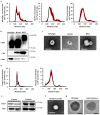GCC2 as a New Early Diagnostic Biomarker for Non-Small Cell Lung Cancer
- PMID: 34771645
- PMCID: PMC8582534
- DOI: 10.3390/cancers13215482
GCC2 as a New Early Diagnostic Biomarker for Non-Small Cell Lung Cancer
Abstract
No specific markers have been identified to detect non-small cell lung cancer (NSCLC) cell-derived exosomes circulating in the blood. Here, we report a new biomarker that distinguishes between cancer and non-cancer cell-derived exosomes. Exosomes isolated from patient plasmas at various pathological stages of NSCLC, NSCLC cell lines, and human pulmonary alveolar epithelial cells isolated using size exclusion chromatography were characterized. The GRIP and coiled-coil domain-containing 2 (GCC2) protein, involved in endosome-to-Golgi transport, was identified by proteomics analysis of NSCLC cell line-derived exosomes. GCC2 protein levels in the exosomes derived from early-stage NSCLC patients were higher than those from healthy controls. Receiver operating characteristic curve analysis revealed the diagnostic sensitivity and specificity of exosomal GCC2 to be 90% and 75%, respectively. A high area under the curve, 0.844, confirmed that GCC2 levels could effectively distinguish between the exosomes. These results demonstrate GCC2 as a promising early diagnostic biomarker for NSCLC.
Keywords: GCC2; biomarkers; cancer; early detection; exosomes; liquid biopsy; non-small cell lung cancer.
Conflict of interest statement
The authors declare no conflict of interest.
Figures




Similar articles
-
GCC2 promotes non-small cell lung cancer progression by maintaining Golgi apparatus integrity and stimulating EGFR signaling pathways.Sci Rep. 2024 Nov 22;14(1):28926. doi: 10.1038/s41598-024-75316-1. Sci Rep. 2024. PMID: 39572606 Free PMC article.
-
Tumor-derived exosomal proteins as diagnostic biomarkers in non-small cell lung cancer.Cancer Sci. 2019 Jan;110(1):433-442. doi: 10.1111/cas.13862. Epub 2018 Dec 6. Cancer Sci. 2019. PMID: 30407700 Free PMC article.
-
Exploration of Serum Exosomal LncRNA TBILA and AGAP2-AS1 as Promising Biomarkers for Diagnosis of Non-Small Cell Lung Cancer.Int J Biol Sci. 2020 Jan 1;16(3):471-482. doi: 10.7150/ijbs.39123. eCollection 2020. Int J Biol Sci. 2020. PMID: 32015683 Free PMC article.
-
Circular RNAs Are Promising Biomarkers in Liquid Biopsy for the Diagnosis of Non-small Cell Lung Cancer.Front Mol Biosci. 2021 May 31;8:625722. doi: 10.3389/fmolb.2021.625722. eCollection 2021. Front Mol Biosci. 2021. PMID: 34136531 Free PMC article. Review.
-
Clinical significance of blood-based miRNAs as biomarkers of non-small cell lung cancer.Oncol Lett. 2018 Jun;15(6):8915-8925. doi: 10.3892/ol.2018.8469. Epub 2018 Apr 12. Oncol Lett. 2018. PMID: 29805626 Free PMC article. Review.
Cited by
-
Exosomal Proteins and Lipids as Potential Biomarkers for Lung Cancer Diagnosis, Prognosis, and Treatment.Cancers (Basel). 2022 Jan 30;14(3):732. doi: 10.3390/cancers14030732. Cancers (Basel). 2022. PMID: 35158999 Free PMC article. Review.
-
Advancing functional foods: a systematic analysis of plant-derived exosome-like nanoparticles and their health-promoting properties.Front Nutr. 2025 Mar 5;12:1544746. doi: 10.3389/fnut.2025.1544746. eCollection 2025. Front Nutr. 2025. PMID: 40115388 Free PMC article. Review.
-
Development and validation of machine learning-based diagnostic models using blood transcriptomics for early childhood diabetes prediction.Front Med (Lausanne). 2025 Jul 16;12:1636214. doi: 10.3389/fmed.2025.1636214. eCollection 2025. Front Med (Lausanne). 2025. PMID: 40740938 Free PMC article.
-
Potential Avenues for Exosomal Isolation and Detection Methods to Enhance Small-Cell Lung Cancer Analysis.ACS Meas Sci Au. 2023 Feb 14;3(3):143-161. doi: 10.1021/acsmeasuresciau.2c00068. eCollection 2023 Jun 21. ACS Meas Sci Au. 2023. PMID: 37360040 Free PMC article. Review.
-
Proteomic Analysis of Lung Cancer Types-A Pilot Study.Cancers (Basel). 2022 May 26;14(11):2629. doi: 10.3390/cancers14112629. Cancers (Basel). 2022. PMID: 35681609 Free PMC article.
References
Grants and funding
LinkOut - more resources
Full Text Sources
Other Literature Sources

